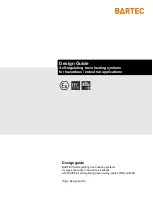
12
ENG
Function and structure
WTS +0300130EN rel. 1.0 - 05.09.2022
4. FUNCTION AND STRUCTURE
4.1 Mode of operation
General principle of reverse osmosis
Osmosis is a natural process, it is understood as the one-sided diffusion of a liquid (here the feed water) through a semi-
permeable membrane. A semi-permeable membrane is only permeable for certain substances.
As the liquid moves through a semi-permeable membrane, the pressure on the side with the lower concentration
decreases and at the same time the pressure of the more concentrated solution increases until a balance is reached,
stopping the water flow. Pressure difference between the two liquids is called “osmotic pressure”.
Reverse osmosis, on the other hand, is a technical process in which the natural process is reversed. It involves applying
a pressure higher than the osmotic pressure to the concentrated liquid so that the water flows in the opposite direction
through the semi-permeable membrane and thus separates the salts solved in the water.
Using this principle, water can be demineralized for drinking water as well as for process and industrial applications.
4.2 Influencing factors
The performance of the reverse osmosis membrane depends strongly on the following parameters:
Water inlet pressure at the membrane:
– By lowering the working pressure, a reduction in permeate production can be achieved.
– By increasing the working pressure, an increase in permeate production is also achieved.
– The pump pressure can be changed by turning the screw on the pump (see chapter 8.4).
– Be careful not to exceed the maximum pump pressure!
Salt content of the feed water:
The higher the salt content, the faster the membrane wear.
Temperature of the feed water:
The ROC unit is set up for a feed water temperature of 15°C. Any difference from this temperature will affect the
production quantity and the quality of the permeate.
The following table shows the variation of the permeate production quantity by 3% per differing 1°C.
Temperature
15 °C
+ 1
+ 2
+ 3
+ 4
+ 5
+ 6
+ 7
+ 8
Correction factor
1
1,03
1,06
1,09
1,12
1,15
1,18
1,21
1,25
Temperature
15 °C
- 1
- 2
- 3
- 4
- 5
- 6
- 7
- 8
Correction factor
1
0,96
0,92
0,88
0,84
0,8
0,77
0,74
0,7
The colder the feed water, the lower the permeate production and the better/lower the conductivity.
The warmer the feed water, the higher the production quantity, but the lower the permeate quality.
4.3 Operating conditions of the unit
The ROC system can be fed with water from the normal water supply if the water has a maximum hardness up to
30°fH.
In order to avoid a reduction of the operating capacity, the water to be treated must comply with certain parameters:
Iron
< 0,15 ppm
Manganese
< 0,05 ppm
Aluminium
< 0,05 ppm
SDI (Silt Density Index)
< 3
Water temperature
5 to 25 °C
Free chlorine
< 0.25 ppm
Hardness
< 30 °fH
Oil and fat
< 0.1 mg/l
COD
< 10 mg/l
TOC
< 3 mg/l
TDS
< 1000μS/cm
SiO2
< 15 ppm
turbidity
< 1 NTU
In some cases the reverse osmosis unit cannot be fed with water from the normal water supply because some elements
contained in the water (free chlorine, iron, suspended solids, hardness minerals) would disturb the osmotic process and
damage the membranes, sometimes irreversibly.
In these cases a pre-treatment is necessary, e.g: De-ironing, de-chlorination, softening with resins or chemical softening
(dosing pump with anti-fogging agent), depending on the characteristics of the water to be treated.
Содержание Compact ROC 140
Страница 2: ......
Страница 6: ......
Страница 35: ...35 ENG Control WTS 0300130EN rel 1 0 05 09 2022...
Страница 50: ...50 ENG Spare parts WTS 0300130EN rel 1 0 05 09 2022 13 SPARE PARTS Fig 13 a Fig 13 b ROC025 to 080 ROC140...
Страница 56: ......
Страница 57: ...Notes...
Страница 58: ...Notes Notes...
Страница 59: ......













































